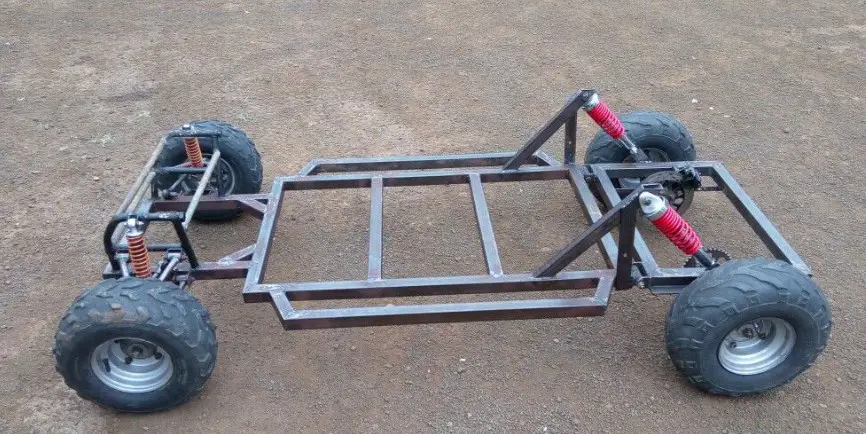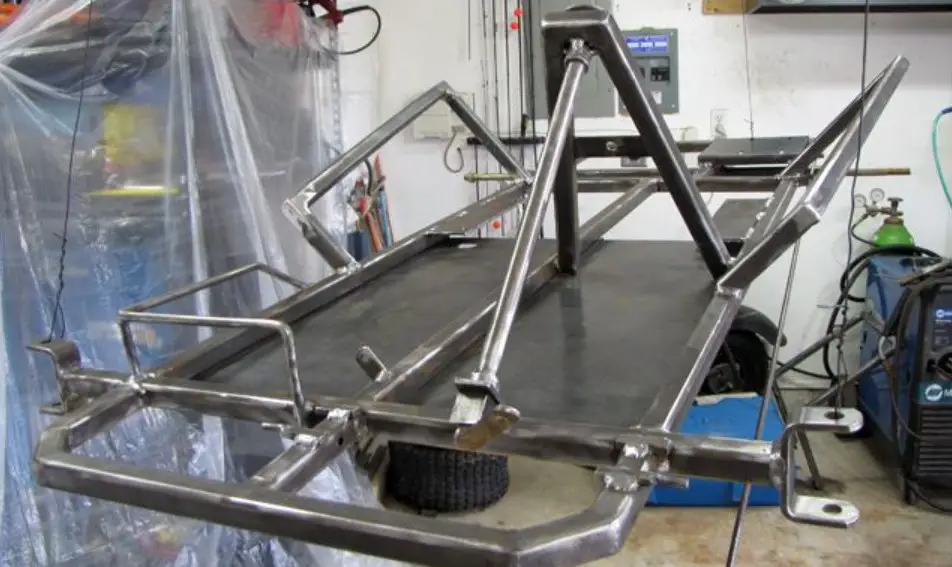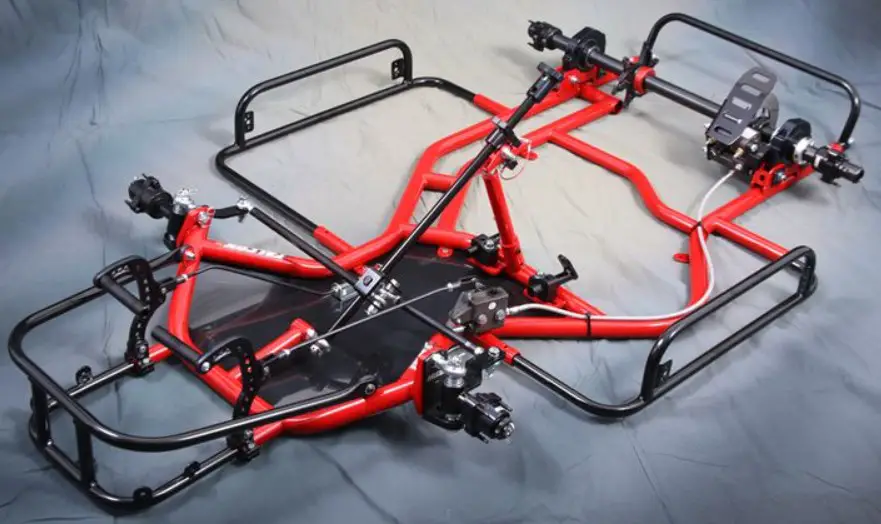A Go-kart frame is considered to be a skeleton of a kart. It is made of different materials. Especially steel, aluminum, and even wood and plastic. It is the most vital and expensive part of a kart. Consequently, a chassis should be stiff, pliable, and convenient. There are 3 types of go-kart chassis depending on the purposes of a go-kart: open or straight chassis, offset frames and specialized or caged frames.
Go-karts are mostly specialized in racing. So, you need to pay attention to the frames when you are planning to purchase a go-kart for yourself or your children. Below, we will give information about all types of go-kart frames and materials to make the best choices.

Straight/Open go-kart frame
As mentioned before, many go-karts are created for sprint racing. For that, straight chassis is the most spread one. It is lightweight and flexible to race and designed in a way a driver sits in the center of a kart. That is why open frames are fast and balanced on the road.

Offset go-kart frame
Offset frames are usually driven for oval karting. A driver’s sit of the frame is located on the left side, so a go-kart can turn only left side. These frames have different sizes, but the difference is not huge. You can choose an offset frame depending on your preference.
Many people recommend larger ones because they are tougher and more resistant to force. They might turn over a go-kart while it is turning only left.

Caged go-kart frame
These frames are constructed as a roll cage of stiffening bars to keep a driver safe on dangerous and dirt tracks. They are made for specific go-kart racing that is long distant. A caged chassis might not be lightweight as open and offset frames. For this kind of race, it should be more durable, enclosed, larger, and heavier.

Materials of a go-kart chassis
The frames are made of 3-4 types of materials. The stiffness, flexibility, and weight totally depend on them. Let’s go through all the types of go-kart materials.

Steel
It is the most reliable material as it is dense, light, and very durable. Professional go-karts are made from steel in the form of tubular, though it costs quite a lot. There are 3 types of steel: AISI 1018, AISI 4130, and stainless steel. They are pretty resembling with some distinctions. Below are a few characteristics of each of them.
AISI 4130 steel alloy has 460 MPa and 560 MPa yield strength and tensile strength respectively. The hardness is 217 HB. Quality standards for this type of steel are quite high. That is why it costs $12 per meter. It is made of chromium (1%) and molybdenum (0.2%), which are strengthening agents.
In comparison, AISI 1018 steel alloy’s yield strength is around 317 MPa and tensile strength equals 440 MPa, and has a hardness of about 126 HB. It has a similar structure but with less percentage of elements than AISI 4130 and contains carbon. The cost of the steel is $5 per meter. AISI 1018 is still good with lower characteristics than the first one, but it is twice cheaper.
The last one is stainless steel, type 304. It has a yield strength of 215 MPa, but its tensile strength is 505 MPa, which is more than that of AISI 1018. The hardness is also great, around 200 HB. Moreover, it is much cheaper than the other 2 types of steel. However, stainless steel is less durable and heavier due to its high density.
Concluding the topic of steels, we can see that AISI 4130 and AISI 1018 steel alloys are the best materials for go-kart frames because of their high-yield strength, hardness, and tensile strength. If you can allow one of these materials, they will serve your racing go-karts very well.
On the other hand, if your go-kart is for the hobby, you can choose stainless steel 304. It has amazing quality for such a little price.

Aluminum
Aluminum go-kart frames are considered to be lighter and cheaper than stainless steel. It is also quite durable, though not as much as steel. Its yield strength is 276 MPa and its tensile strength is 310 MPa, so you can use a small engine. Also, the hardness is around 70 HB.
Another point is that it is hard to weld aluminum because of its high heat conductivity, and needs very high temperatures.
According to the data, aluminum chassis is recommended to use for homemade karts, not for high speeds and loads. So, it is not the best go-kart frame material.

Wood & hard plastic
Wood is a rare material that people use for chassis construction. It can be used for kid-karts. It has a yield strength of 40 MPa, a tensile strength of 2 MPa, and a hardness of 4 HB, which is too little. So, it is certainly not a racing go-kart frame. You can use it for homemade karts and drive at low speeds. It can be driven thanks to electricity, but a standard engine is not suitable, since wood is too soft for that.
The hard plastic is also used for the construction of a go-kart chassis. It is not for races as well and soft material too. However, for homemade karts and karts for kids, plastic is one of the best options. Also, the cost is very cheap, you surely can afford it.

Size of go-kart frames
The size of go-karts and chassis are mostly similar to each other. Nevertheless, there are differences between them depending on the type of frame.
Straight chassis should have a longer front and shorter back. Also, you should pay attention to the sizes of steel tubing. The difference between them is a few millimeters, but their impact is not a little.
In offset chassis, there is variety in length and width. If a frame is longer by a few inches, the kart will be more downforce. Moreover, you need to consider the size of the tubing. The larger the tubing, the stiffer your chassis.
Frames off-road karts are usually heavier and bigger than others since it is designed as roll cage, and should have shorter front and longer back. It is because while driving on a dangerous track, much force will be concentrated on the front side.

The size of a go-kart frame depends on racing classes by the age of the drivers. There are 5 karting categories:
- Kid karting (5-7 y.o.) – 26 mm of tubing
- Cadet karting (7-12 y.o.) – 28 mm of tubing
- Junior karting (12-15 y.o.) – 30 mm of tubing
- Senior karting (15+ y.o.) – 32 mm of tubing
- Master karting (35+ y.o.)- only 32 mm of tubing
So, the size of a go-kart chassis depends on the type of the go-kart frame and your age.

The common and best frame type
To choose a go-kart frame, you need to establish an engine first. The most ordinary two-cycle engine is called Yamaha KT-100. Then you should define in which racing you will use your go-kart. Depending on the purpose, you select the material of the chassis. After, you select the frame that fits your engine.
There are also 2 forms of chassis, basic qualities: stiff frames and flexible frames. These qualities depend on the length of the torsion bars. Shorter torsion bars say that kart frames are stiff.
Longer torsion bars mean that they are more flexible. You can change the stiffness by adding or removing torsion bars. According to your preferences and using the given information, you can select the right go-kart frame.

Conclusion
Go-kart chassis vary depending on the materials from which they are made and their purposes. There are 3 types of frames for 3 different tracks. Straight frames for racing go-karts, offset for oval tracks, and caged for off-road kart racing. You need to understand each of them and choose one.
The best frame has to be stiff, quite flexible, light, and fast. It should be made of a good material, especially steel. AISI 4130 and AISI 1018 are the best versions, but usually, people choose stainless steel for go-karts. It is cheap and hard, much better than aluminum, wood, and plastic.
Also, consider the age of the driver and select the right size. The older the driver, the more size of a frame and tubing you need. It is for convenience and safety.
These are all our tips and recommendations from us about go-karts and chassis. Bear in mind every detail before you buy any of them. We hope the given instructions will help you to select the right chassis and enjoy karting.

FAQ
As mentioned before, there are 3 types of chassis and all of them are used in a go-kart. Open frames are used in sprints on asphalt tracks. The second type, offset chassis, is used in oval racing, where karts turn only left. Finally, caged frame for off-road racing, where the speed is not the major part.
Good go-kart chassis, firstly, are used for their purposes. Secondly, their material should be reliable and made of steel. Stiffness and flexibility also have to be considered because they are the main qualities of chassis. Moreover, take into account the weight and hardness of a frame. Lightweight and high strength will give the advantage in the race.
There are also 3 types of karts: sprint, oval, and enduro. They are like the types of frames. Sprint karts are the most spread type. You might see them all the time on racing.
The second one is oval karts. As mentioned above, they tend to turn only left in racing on oval tracks. The driver’s sit is located on the left side, which is why its structure is unique.
The last type is enduro go-karts. They are the fastest ones and are used only by professionals. Drivers lay down in the karts to increase and reach the maximum speed.
Read also: 7 Best Go-kart Tracks in Indiana to Enjoy Riding